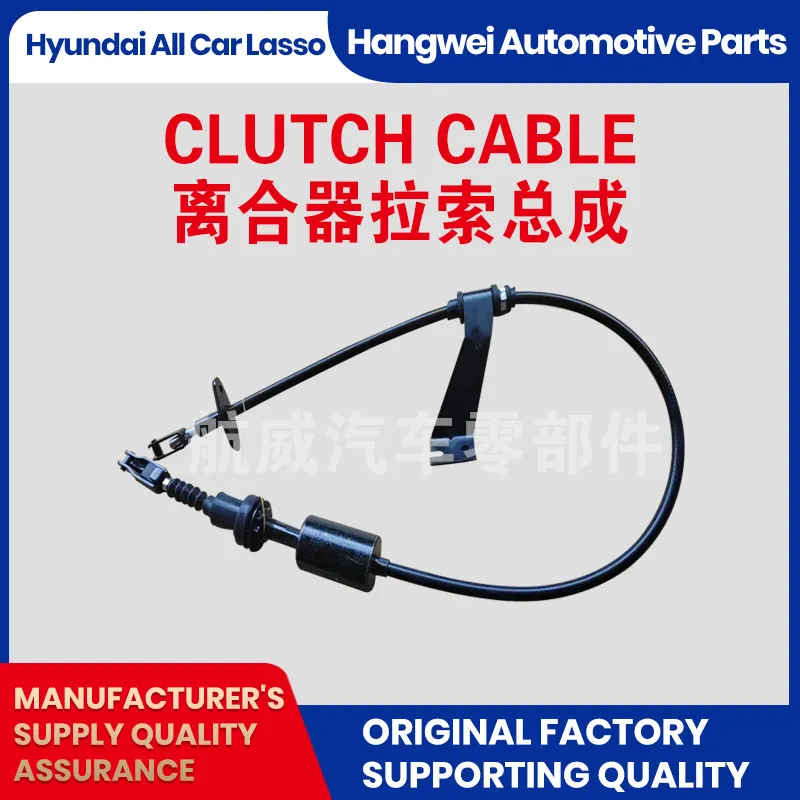Clutch Line: Stainless, Leak-Free, Fast Response - Why Us?
Inside the Modern Clutch Push-Pull Cable: What Matters, What’s Hype
When folks say clutch line, they usually mean the whole mechanical path that translates pedal force into clean clutch actuation. I’ve toured more than a few cable plants and test labs, and—honestly—the devil is in the liners, the metallurgy, and the way everything is crimped and sealed. The Clutch Push-Pull Cable from HWEI Cable (origin: Qinghe County Minjiang Street south, Wuzhishan Road east) leans into that, with tight process control and the kind of testing you’d expect from an OEM-tier supplier.

Why this matters right now
Vehicles are getting heavier, pedal feel expectations are rising, and cost pressure is relentless. The humble clutch line has to deliver lower friction, consistent stroke, and survive salt, heat, mud—sometimes all in the same week. Trends I keep hearing: PTFE liners with tuned lubricity, pre-stretched wire rope for reduced initial creep, and better boot/seal designs to keep road grit out. Surprisingly, a small tweak in liner compound can change pedal feel more than a thicker cable ever will.
Typical specs (real-world use may vary)
| Parameter | Spec | Notes |
|---|---|---|
| Inner wire | SUS304 or galvanized steel, 7×7 or 7×19 | Pre-stretched; tensile ≈ 4–8 kN depending on diameter |
| Liner | PTFE low-friction | Friction drop ≈ 15–25% vs. PA-only |
| Conduit | PA/HDPE with steel spiral armor | Compression resistance for routing tight bends |
| End fittings | Zinc-plated steel or SS; swaged | Pull-off > spec by ≈ 20% typical |
| Service life | >200,000 cycles bench-tested | Field life ~ 5–8 years; climate dependent |
Process flow (how it’s actually built)
- Materials: SUS304 or galvanized wire rope, PTFE liner, PA/HDPE conduit, EPDM boots, zinc-plated fittings.
- Methods: wire pre-stretching, multi-die swaging, crimp validation, liner extrusion, silicone or dry-film lubrication.
- Testing: tensile to failure (ASTM-style), reverse bend (ISO 7800), salt spray 240–480 h (ASTM B117/ISO 9227), cycle rigs at -30°C to +120°C.
- Traceability: heat/lot stamped; QMS aligned to IATF 16949.
Where it’s used
Passenger cars, motorcycles, light trucks, forklifts, ag & off-highway, and some marine setups. In stop‑and‑go cities, a low-friction clutch line really cuts fatigue; on track days, temperature stability matters more. Fleet managers tell me they want fewer adjustments over time—this design helps.
Customization (because routing is everything)
- Length/throw tuned to pedal and release arm geometry.
- Boots, brackets, and grommets matched to firewall and gearbox mounts.
- End fittings: clevis, eyelet, ball-stud, custom swaged ends.
- Corrosion class: standard zinc, Zn-Ni, or stainless assemblies for harsh coastal routes.
Vendor snapshot (indicative)
| Vendor | Certifications | Customization | Lead Time | Notes |
|---|---|---|---|---|
| HWEI Cable (Qinghe County) | ISO 9001, IATF 16949 | High—tooling in-house | ≈ 3–5 weeks | Strong QC, salt-spray options |
| Vendor B | ISO 9001 | Medium | 4–7 weeks | Competitive pricing |
| Vendor C | IATF 16949 | High | 5–8 weeks | Strong OEM references |
Field notes and data
- Bench tests: friction coefficient down ≈ 18% vs. rubber-lined cable; stroke consistency ±3% after 200k cycles.
- Corrosion: fittings intact after 480 h salt fog; cosmetic white rust only on standard zinc parts.
- Customer feedback: “pedal lighter in winter,” “fewer re-adjustments after break-in.” It seems that pre-stretching helps.
Mini case studies
- Urban delivery fleet: clutch line replacement intervals extended from 24 to ~40 months; technician notes reduced cable drag in cold starts.
- Motorcycle OEM: switched to PTFE liner; warranty claims on actuation stiffness dropped ≈ 27% over two seasons.
- Forklift plant: custom end fittings and heat sleeve; assembly time down 12% thanks to easier routing.
Certifications and standards referenced below are commonly used benchmarks; final specs depend on the platform and region.
- IATF 16949:2016 – Automotive Quality Management Systems. https://www.iatfglobaloversight.org
- ASTM B117 – Standard Practice for Operating Salt Spray (Fog) Apparatus. https://www.astm.org/b117
- ISO 9227 – Corrosion tests in artificial atmospheres — Salt spray tests. https://www.iso.org/standard/63543.html
- ISO 7800 – Metallic materials — Wire — Reverse bend test. https://www.iso.org/standard/14136.html
- EN 12385 (Steel wire ropes — Safety). https://standards.iteh.ai/catalog/standards/cen/8d7e2cbf-0f83-4e19-8e2a-9e9324e9f0a7/en-12385-1
-
Clutch Line: Braided, Leak-Proof, OEM-Grade PerformanceNewsNov.10,2025
-
Throttle Cable: Durable, Smooth Control & Universal FitNewsNov.10,2025
-
Throttle Cable: Durable, Smooth, Universal Fit, Easy InstallNewsNov.10,2025
-
Clutch Line: Durable, Leak-Proof, OEM-Grade PerformanceNewsNov.10,2025
-
Hand Brake Cable | Custom, Universal & Trailer SolutionsNewsNov.10,2025
-
Clutch Line: High-Pressure, OEM-Fit, Corrosion-ResistantNewsNov.03,2025
